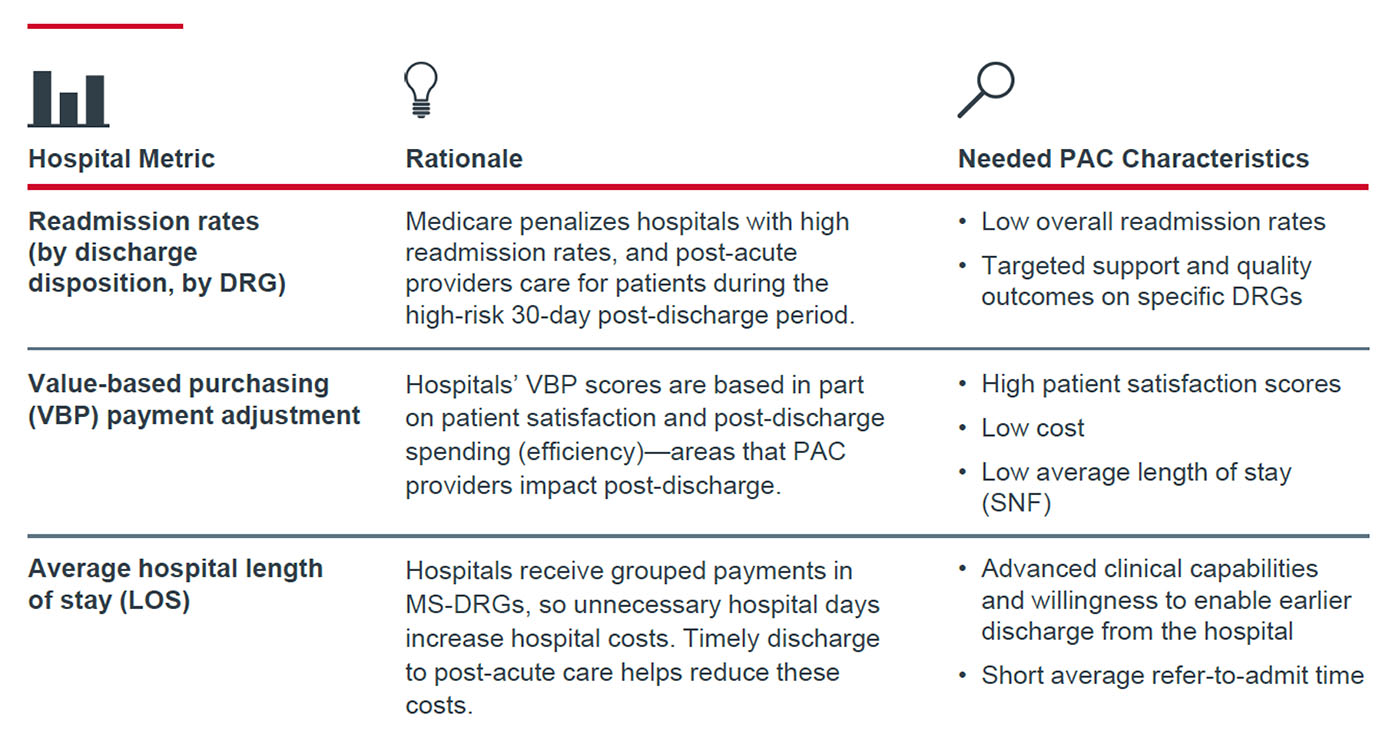Auto logout in seconds.
Continue LogoutBefore engaging potential post-acute care (PAC) partners in active collaboration, a hospital should conduct an internal analysis of the current status of its PAC relationships and its strategic needs with respect to post-acute care. This current-state baseline informs the goals and composition of the network.
Below, we delve into some of the specific metrics that many health systems use to evaluate their existing network and outline the specific metrics one of our members used during their evaluation.
To learn more about our recommended approach to how you should structure your post-acute network, download our guide: PAC 101: The Rationale for a Post-Acute Network - Part 3: How can you build a post-acute network?
To access our complete library of assets, case studies, insights, tools, best practices and other relevant post-acute care topics, visit our home page.
Before engaging potential PAC partners in active collaboration, a hospital should conduct an internal analysis of the current status of its PAC relationships and its strategic needs with respect to post-acute care. This current-state baseline informs the goals and composition of the network and therefore influences the development process, in two areas:
Current Post-Acute Relationships:
First, hospitals should identify PAC providers with whom they have substantial existing relationships, e.g., those that accept high patient volumes from the hospital or employ a hospital physician as medical director. A present strong relationship facilitates a smooth and expedited commencement of active partnership, for example, by reducing the need to alter discharge planner behavior. As such, these PAC providers should be prioritized for network placement (as long as they also demonstrate strong performance, assessed in Steps 3 and 4).
Hospital’s Post-Acute Goals:
Next, the hospital should identify main problem points related to post-acute care in order to focus network goals and prioritize incorporating PAC providers equipped to support those goals into the network. For example, a hospital experiencing high readmission rates for heart failure patients (and therefore readmission penalties) should partner with PAC providers with good outcomes for heart failure patients. Note that major hospital post-acute goals may be impacted by which payment programs the hospital is participating in.
Complimentary Resource: Our recommended three-tier strategy to developing an optimal post-acute care network
As an example, below we outline three key metrics to assess, and what they indicate about needed network composition. We also provide a downloadable PDF that lists the key metrics one of our members used when they evaluated their post-acute network before optimization.

A sample assessment providing a full range of metrics can be downloaded here.
Through performing a thorough analysis of your present day needs and existing partnerships, your organization can strategically identify the most optimal partners and create the ideal network for your needs and objectives.
Don't miss out on the latest Advisory Board insights
Create your free account to access 1 resource, including the latest research and webinars.
Want access without creating an account?
You have 1 free members-only resource remaining this month.
1 free members-only resources remaining
1 free members-only resources remaining
You've reached your limit of free insights
Become a member to access all of Advisory Board's resources, events, and experts
Never miss out on the latest innovative health care content tailored to you.
Benefits include:
You've reached your limit of free insights
Become a member to access all of Advisory Board's resources, events, and experts
Never miss out on the latest innovative health care content tailored to you.
Benefits include:
This content is available through your Curated Research partnership with Advisory Board. Click on ‘view this resource’ to read the full piece
Email ask@advisory.com to learn more
Click on ‘Become a Member’ to learn about the benefits of a Full-Access partnership with Advisory Board
Never miss out on the latest innovative health care content tailored to you.
Benefits Include:
This is for members only. Learn more.
Click on ‘Become a Member’ to learn about the benefits of a Full-Access partnership with Advisory Board
Never miss out on the latest innovative health care content tailored to you.

